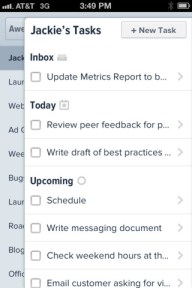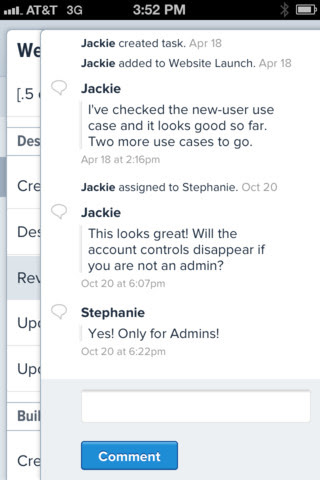
Group task manager startup Asana launched its first native mobile app last week. It’s mostly a straight port of its existing mobile web app, so the main benefit at present is that switching back and forth with other apps is much faster than dealing with Safari.
The company says it’s planning to invest in native apps more over time, but the version available is already useful for me since I’ve been dumping all of my story ideas into Asana since I started at TechCrunch in November… because I’m on my phone all the time, and checking Asana to see what I need to do next while I’m also trying to do three or four other things.
If you’re not familiar, the stand-out feature of Asana’s mobile experience is that the projects, task lists and individual task windows from the web app now appear as layers within the home screen.
The left-hand projects bar forms the bottom layer. If you press on one of your projects, its task items slides in from the right to appear as the next layer. If you touch any task, its pane then comes in to form the third layer.

To navigate back from lists or individual items, click on mostly submerged window on the left. The overall feeling is so natural that after a few days of using it I had to stop myself from pressing on my computer monitor to simulate the same experience.
The main downside to the mobile experience, at least for now, is that you can’t create or reassign tasks to others. Instead, any task you create just defaults to yourself and you’ll need to change it on the web site later. Expect everything to improve rather quickly, though. The company iterates fast, recently adding a repeat-event feature to tasks that others and myself had been wanting, for example. (Although it still hasn’t added time of day, which would be helpful for those of us who need to manage a lot of tight deadlines).
Overall, yes, there are dozens and dozens of other task manager type apps out there, and I know because I’ve tried using many of them over the years. Asana is approaching this consumery-enterprise space the right way, by not trying to add in too many features or forcibly define how people can to use it. I’m including Basecamp in the “other” category, as I’ve always found it to be overwrought (or as designer Damian Madray put it, ”Basecamp is to Asana as Android is to iPhone”). Instead, Asana focuses on nailing a few features right then adds on the right extras on top, as my friend Dan Kaplan explored in this recent article. It also does what many competitors don’t, which is provide a seamless user experience across web and (supported) mobile devices.
You can download the iPhone app here.
[Screenshots via Asana, because I don't want to show everyone what I'm working on next]
Source:http://techcrunch.com/2011/12/27/appsana/
The company says it’s planning to invest in native apps more over time, but the version available is already useful for me since I’ve been dumping all of my story ideas into Asana since I started at TechCrunch in November… because I’m on my phone all the time, and checking Asana to see what I need to do next while I’m also trying to do three or four other things.
If you’re not familiar, the stand-out feature of Asana’s mobile experience is that the projects, task lists and individual task windows from the web app now appear as layers within the home screen.
The left-hand projects bar forms the bottom layer. If you press on one of your projects, its task items slides in from the right to appear as the next layer. If you touch any task, its pane then comes in to form the third layer.

To navigate back from lists or individual items, click on mostly submerged window on the left. The overall feeling is so natural that after a few days of using it I had to stop myself from pressing on my computer monitor to simulate the same experience.
The main downside to the mobile experience, at least for now, is that you can’t create or reassign tasks to others. Instead, any task you create just defaults to yourself and you’ll need to change it on the web site later. Expect everything to improve rather quickly, though. The company iterates fast, recently adding a repeat-event feature to tasks that others and myself had been wanting, for example. (Although it still hasn’t added time of day, which would be helpful for those of us who need to manage a lot of tight deadlines).
Overall, yes, there are dozens and dozens of other task manager type apps out there, and I know because I’ve tried using many of them over the years. Asana is approaching this consumery-enterprise space the right way, by not trying to add in too many features or forcibly define how people can to use it. I’m including Basecamp in the “other” category, as I’ve always found it to be overwrought (or as designer Damian Madray put it, ”Basecamp is to Asana as Android is to iPhone”). Instead, Asana focuses on nailing a few features right then adds on the right extras on top, as my friend Dan Kaplan explored in this recent article. It also does what many competitors don’t, which is provide a seamless user experience across web and (supported) mobile devices.
You can download the iPhone app here.
[Screenshots via Asana, because I don't want to show everyone what I'm working on next]
Source:http://techcrunch.com/2011/12/27/appsana/

No comments:
Post a Comment